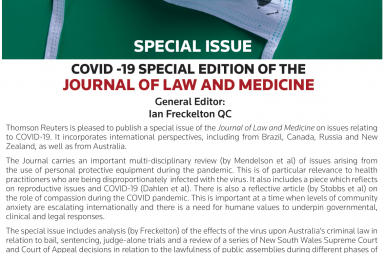The latest issue of The Tort Law Review (Volume 19 Part 1) contains the following material:
Articles
Constructing a framework for assessing public authority liability in negligence: The role of public law norms, private law norms and policy arguments – Swati Jhaveri
This article evaluates the different norms and arguments that the courts have used to deal with the question of whether a public authority owes a duty of care to a particular claimant. In analysing the law in the area, the author identifies three decision-making tools used by the courts: private law norms, public law norms and policy arguments. She argues that a common problem with the courts’ use of these tools is inattention to the different categories of cases involving public authorities and that the courts should adopt different strategies in deciding a case, depending on the category of the case. Two categories of cases are identified here: discrete cases of negligence and cases of systemic negligence. It is argued that the latter are unsuitable for resolution via tort law. The author proposes an alternative decision-making approach that is sensitive to the different categories of cases and that is based on a calibrated use of the different norms and arguments for each category. In proposing this alternative, she identifies three risks with adopting “skewed†approaches that tend to favour the application of any one set of norms or arguments, characterising these problems as categorical problems, compliance-based problems and dialogic problems. The author concludes by highlighting the potential that the alternative approach proposed has to facilitate a more cooperative dialogue between the judiciary and the executive that is based on a greater shared understanding of the scope and application of the tort of negligence in relation to public activities.
To purchase this article, complete the Individual Article Sale order form and email it to [email protected].
Recovery for psychiatric illness in Canada: A tale of two cases – Peter Handford
Mustapha v Culligan of Canada Ltd [2008] 2 SCR 114 was the Supreme Court of Canada’s first opportunity for more than 50 years to restate the principles of liability for psychiatric injury as applied in Canada. However, McLachlin CJ’s economically worded judgment did not go into the issues in any detail. In the recent case of Healey v Lakeridge Health Corp 2011 ONCA 55, the Ontario Court of Appeal had to resolve an ambiguity in McLachlin CJ’s judgment: the plaintiffs argued that it had lowered the recognisable psychiatric illness threshold, but the Ontario Court of Appeal upheld the orthodox view. Healey, however, affirms another distinctive trend seemingly initiated by Mustapha: to treat issues of psychiatric injury under the heading of remoteness rather than duty.
To purchase this article, complete the Individual Article Sale order form and email it to [email protected].
Planning permission, the law of nuisance and human rights – Francis McManus
The courts take a variety of factors into account when determining if an adverse state of affairs ranks as a nuisance in law. The list of such factors is not closed. One such factor is the nature of the relevant locality in which the adverse state of affairs exists. Since 1947 the powers of the state to dictate how land in a particular area may be developed, by reason of which, of course, the nature of the locality will often change, have dramatically increased. However, it is only relatively recently that the English courts have addressed the issue whether planning permission and policy can, in the eye of the law, have the effect of changing the character of the land for the purposes of the law of nuisance. This article discusses the relevant case law with special reference to the Scottish planning regime and the expanding corpus of human rights jurisprudence.
To purchase this article, complete the Individual Article Sale order form and email it to [email protected].
Liability for bullying: Holding schools accountable – Eva English
Bullying is a problem that has always plagued schoolyards, and has now spread to the online realm with cyber bullying taking place on social networking sites, chat rooms and instant messaging. The fight against bullying requires a multidisciplinary approach, and this article emphasises the role that tort law can play in this fight. This article first addresses the ways in which the victim may sue the aggressor directly. Further, it notes the responsibility that is placed with schools to ensure a safe learning environment. Teachers and schools need not be responsible for every negative incident that occurs between students. Rather, a reasonable level of responsibility is placed on teachers and school boards by the common law. If they violate this standard, they may be subject to liability. This article discusses case law related to negligent supervision, as well as examples of legislation intended to combat bullying. Issues with respect to the tension with freedom of speech/expression are also raised. Finally, this article discusses the new challenges posed by cyber bullying and areas of the law still to be explored.
To purchase this article, complete the Individual Article Sale order form and email it to [email protected].
Comment
Defamation: Meanings, parliamentary privilege and negligence – Ursula Cheer
For the pdf version of the table of contents, click here: Tort L Rev Vol 19 Pt 1 Contents.


